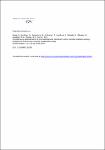Simultaneous quantification of five bacterial and plant toxins from complex matrices using a multiplexed fluorescent magnetic suspension assay
Pauly, Diana
Kirchner, Sebastian
Stoermann, Britta
Schreiber, Tanja
Kaulfuss, Stefan
Schade, Rüdiger
Zbinden, Reto
Avondet, Marc-André
Dorner, Martin
Dorner, Brigitte
Proteotoxins such as ricin, abrin, botulinum neurotoxins type A and B (BoNT/A, BoNT/B) and staphylococcal enterotoxin B (SEB) are regarded as potential biological warfare agents which could be used for bioterrorism attacks on the food chain. In this study we used a novel immunisation strategy to generate high-affinity monoclonal and polyclonal antibodies against native ricin, BoNT/A, and BoNT/B. The antibodies were used along with antibodies against SEB and abrin to establish a highly sensitive magnetic and fluorescent multiplex bead array with excellent sensitivities between 2 ng/L and 546 ng/L from a minimal sample volume of 50 µL. The assay was validated using 20 different related analytes and the assay precision was determined. Advancing the existing bead array technology, the novel magnetic and fluorescent microbeads proved amenable to enrichment procedures, by further increasing sensitivity to 0.3–85 ng/L, starting from a sample volume of 500 µL. Furthermore, the method was successfully applied for the simultaneous identification of the target toxins spiked into complex food matrices like milk, baby food and yoghurt. On the basis of our results, the assay appears to be a good tool for large-scale screening of samples from the food supply chain.
Dateien zu dieser Publikation
Keine Lizenzangabe

